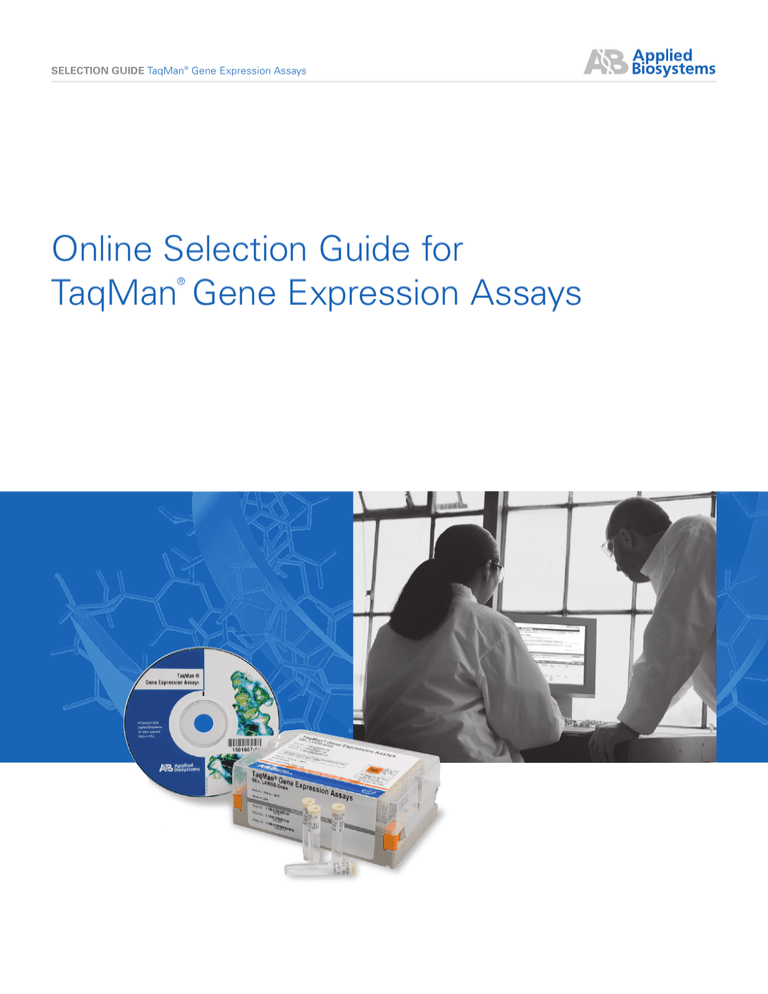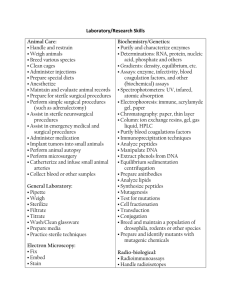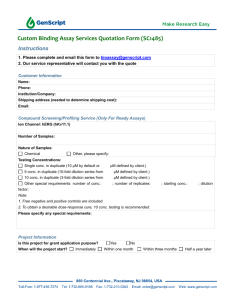Online Selection Guide for TaqMan® Gene Expression Assays
advertisement

selection guide TaqMan® Gene Expression Assays Online Selection Guide for TaqMan Gene Expression Assays ® TaqMan® Gene Expression Assay Selection Guide This guide is designed to help scientists find and select the best TaqMan® Gene Expression Assay for their research needs. Often, the choice of the “right” assay is driven by the scientific needs of the experiment. For more information on how to query and order assays, please consult our Online Ordering Guide for TaqMan® Gene Expression Assays (127MI64-01). SECTION 1: FILTERING Query Results by ASSAY AVAILABILITY Inventoried assays have the fastest delivery time. In addition, Inventoried assays have smaller volumes than Made-to-Order (MTO) assays, and are therefore less expensive. Inventoried assays are typically delivered in 2–5 days, and MTO assays are typically delivered in 6–8 days. 1B 1A 2A From the Search Results page: 2E 1A.Choose “Inventoried” or “Made to order” assay. 2B 2D 1B.Click “Filter Results”. 2F SECTION 2 : USING the Information on the Query Results Page to Narrow Results 2A.Confirm Gene Symbol, Gene Name, Alias, and Species. 2G 2B.Choose by number of RefSeq transcripts recognized. For splice variant independent gene expression, select the assay with the most RefSeqs. To look at expression of a particular splice variant, select an assay specific for that variant. 2C.Pick the assay with the most GenBank mRNA transcripts for splice variant-independent gene expression if there are no RefSeqs. 2D.Check Assay ID suffix. For example, “_m1” means the assay crosses an exon junction, and is therefore unlikely to be impacted by genomic DNA contamination. See Glossary for a complete list of suffix definitions. 2E.Select shorter amplicon size if your starting material is degraded. 2F.Click on the Assay ID to obtain more detailed information (Section 3: Assay Information Page). 2G.Click “Alignment Map” to view all mRNA transcripts and TaqMan Gene Expression Assays (Section 4: GeneAssist™ Alignment Map). 1 2C SECTION 3 : Assay Information Page This page provides additional assay information to help make or confirm an assay selection, such as gene name, transcripts detected, exon boundary, assay location, and much more (see the FAQ and Glossary sections at end of this document for definitions of these terms). 3A 3B To select an assay that detects a particular accession number, use the Alignment Map (3B) or refer to Interrogated Sequence table (3C). 3A.Link to Entrez Gene for extensive information 3E about the gene and all of its transcripts. 3C 3B.Click “Alignment Map” to view all gene transcripts and TaqMan Assays. 3D 3C.The Interrogated Sequence table shows all the transcripts that the assay will detect. 3D.Link to NCBI database for detailed information on RefSeq and GenBank mRNA. 3F 3E.Use Exon Boundary to understand probe mapping across exons. 3F.Review Assay Details section for features of the assay not captured elsewhere. TIPS - To confirm a microarray hit, select an assay that interrogates the same region as the microarray probe - For splice variant analysis, use the Alignment Map to select an assay that maps to all transcripts, or differentiates the transcript of interest SECTION 4 : GENEASSIST ™ ALIGNMENT MAP The GeneAssist™ Alignment Map is a graphical view of the assay’s probe location mapped to transcripts. 4A 4A. G ene symbol. 4B 4B.Graphical representation of probes for each assay depicted. Most assays span exons. 4C.A “ * “ indicates an Inventoried TaqMan Gene Expression Assay. 4C 4D 4D.Graphical representation of all transcripts showing alternate exon usage. 4E 4E. Show/hide GenBank mRNA. 4F.Show/hide all TaqMan Assays. 2 4F glossary Assay nomenclature: The first two letters in the Assay ID represent the species. The letters after the underscore give information about the assay placement. Example Assay ID: Hs00380483_m1 (Human assay #00380483, which spans an exon junction). Hs – Homo sapiens Mm – Mus musculus Rn – Rattus norvegicus Dm – Drosophila melanogaster At – Arabidopsis thaliana Ce – Caenorhabditis elegans Cf – Canis familiaris Rh – Macaca mulatta (Rhesus) Dr – Danio rerio (Zebrafish) The gene expression Assay ID suffix indicates the assay placement: • “_m” indicates an assay whose probe spans an exon junction and will not detect genomic DNA. • “_s” indicates an assay whose probes and primers are designed within a single exon. Such assays will, by definition, detect genomic DNA. • “_g” indicates an assay that may detect genomic DNA. The assay probe and primers may also be within a single exon. • “_mH”, “_sH”, or “_gH” indicates that the assay was designed to a transcript belonging to a gene family with high sequence homology. The assays have been designed to give between 1,000– 30,000-fold greater discrimination from the closest homologous transcript. • “_u” indicates an assay whose amplicon spans an exon junction and the probe sits completely in one of the spanned exons. • “_ft” indicates the assay is designed to detect fusion transcripts that result from chromosomal translocation. The probe and one primer are on one side of the fusion transcript breakpoint; the second primer is on the other side of the fusion transcript breakpoint. The assay does not detect genomic DNA. • “_at” indicates the assay is designed to detect a specific synthetic RNA transcript with a unique sequence that lacks homology to current annotated biological sequences. Inventoried: Assays have already been manufactured and are available for shipment from Applied Biosystems. Delivered as 20X formulation, 250 total 20-µL reactions (1X primer concentrations, 900 nM; 1X probe, 250nM). Made-to-Order: Assays that have been designed and manufactured as soon as an order is received. Because these assays need to be manufactured, the delivery time is longer than that for inventoried assays. Delivered as 20X formulation, 360 total 20-µL reactions (1X primer concentrations, 900 nM; 1X probe, 250nM). Amplicon length: Length of the PCR amplicon generated by the TaqMan Assay. Shorter amplicons may be slightly more efficient. Assay location: The assay location refers to the nucleotide location that is the midpoint of the context sequence for the associated accession number. The 25bp context sequence contains the probe sequence. To find the context sequence, go to the assay location and count 12 bases on either side. TaqMan® MGB probes are generally 15–18 bases long. Example: CATTCTAGCTGATCATTGAGATGTCC 25bp context seq / probe seq Assay location Exon boundary: This information gives the location of the probe. For example, “2–3” means that the TaqMan® probe of the assay was designed across the exon 2–exon 3 junction of the transcript (RefSeq, GenBank mRNA or Celera) listed. A probe that lies within a single exon will show that exon. faq What can I do if my search gives 0 results? A) Use the ”All Text” option to widen your search. B) If using gene symbols (e.g., IL2), try retyping without spaces and dashes. C) If using RefSeq accession numbers (e.g., NM_014440.1), type in with correct syntax without any version number (e.g., NM_014440). Any version number should be eliminated (e.g., .1). D) Consider ordering a Custom TaqMan® Gene Expression Assay. How can I find out about pathway information? A) The GeneAssist™ Pathway Atlas (www.ambion. com/tools/pathway/all_pathway_list.php) provides the ability to search or browse pathways by gene name or pathway name. The pathway of interest is displayed as a Pathway Map; a color graphical display of the pathway. B) The Gene Ontology information on the Assay information page gives information on disease, pathway and gene function. How can I get more info about the assay in its genomic context? Entrez Probe at NCBI provides more information about TaqMan Assays, including a Gene Viewer that shows all assays and other probes for the gene of interest. Should I pick an Inventoried or Made-to-Order assay? All assays have been designed through the same validated bioinformatics process. Inventoried assays have the advantages of faster delivery time and smaller volumes. However, you should pick the as- say that best suits your experiment. For example, if you’re studying a particular splice variant, make sure the assay you choose detects a RefSeq or GenBank mRNA for that particular transcript. If you’re doing microarray data validation, make sure the assay detects a transcript that matches the array probe or target. What else do I need to order with the TaqMan Assays for my experiment? The following kits were developed and validated for use with TaqMan Assays: • High Capacity cDNA Reverse Transcription Kit • TaqMan® Gene Expression Master Mix • TaqMan® PreAmp Master Mix • TaqMan® Endogenous Controls • TaqMan® Gene Expression Cells-to-C Kit T For Research Use Only. Not for use in diagnostic procedures. Practice of the patented 5’ Nuclease Process requires a license from Applied Biosystems. The purchase of TaqMan® Gene Expression Assays includes an immunity from suit under patents specified in the product insert to use only the amount purchased for the purchaser’s own internal research when used with the separate purchase of an Authorized 5’ Nuclease Core Kit. No other patent rights are conveyed expressly, by implication, or by estoppel. For further information on purchasing licenses contact the Director of Licensing, Applied Biosystems, 850 Lincoln Centre Drive, Foster City, California 94404, USA. ©2008 Applied Biosystems. All rights reserved. Applera, Applied Biosystems, and AB (Design) are registered trademarks and GeneAssist is a trademark of Applera Corporation or its subsidiaries in the US and/or certain other countries. TaqMan is a registered trademark of Roche Molecular Systems, Inc. All other trademarks are the sole property of their respective owners. Printed in the USA, 02/2008 Publication 127GU08-01 Headquarters 850 Lincoln Centre Drive | Foster City, CA 94404 USA Phone 650.638.5800 | Toll Free 800.345.5224 www.appliedbiosystems.com International Sales For our office locations please call the division headquarters or refer to our Web site at www.appliedbiosystems.com/about/offices.cfm


